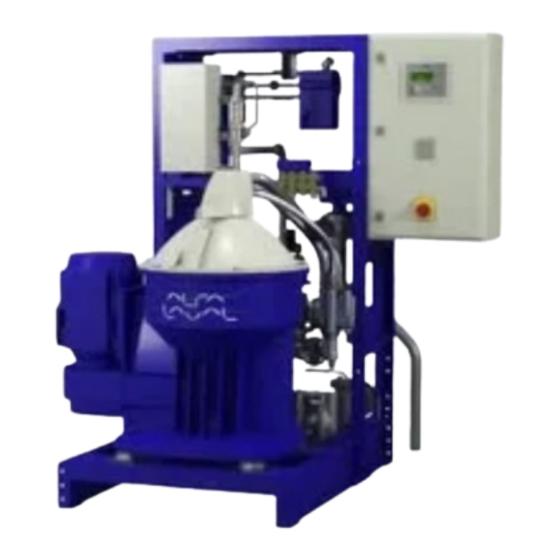
Summarization of Contents
Safety Instructions
Warning Signs in Text
Defines DANGER, WARNING, CAUTION, NOTE symbols for personnel safety.
Environmental Issues
Guidelines for handling unpacking materials and waste disposal for environmental protection.
Requirements of Personnel
Specifies qualifications and training for personnel operating or maintaining the separator.
Basic Principles of Separation
Separation By Gravity
Explains gravity-driven separation of liquids and solids in a stationary bowl.
Centrifugal Separation
Details how centrifugal force achieves rapid separation in the rotating separator bowl.
Temperatures
Discusses temperature's effect on viscosity and density for separation efficiency.
Design
Overview
General description of the separator's main sections and components.
The Drive Section
Explains components driving the separator, including motor and belt transmission.
The Process Section
Details parts for liquid processing, such as the inlet/outlet unit and bowl.
Sensors
Describes types of sensors for monitoring separator operation, including optional ones.
Separating Function
Explains how the separator separates water and solids from uncleaned oil.
Operating Instructions
Before First Start-up
Outlines procedures and checks before the initial start of the separator.
Start After Service
Advises on checks after maintenance before starting the separator.
Before Normal Start
Lists checks required for normal separator operation readiness.
Start
Step-by-step guide for starting the separator and initial checks.
Operating
Describes checkpoints to monitor during the separator's operation.
Stop
Provides instructions for safely stopping the separator and performing sludge discharge.
Emergency Stop
Details immediate shutdown procedures for excessive vibration or hazards.
Service, Dismantling, Assembly
Periodic Maintenance
Explains the importance and types of preventive maintenance for the separator.
Maintenance Log
A log to record performed maintenance tasks and intervals.
Dismantling
Step-by-step guide for disassembling the separator and its components.
Actions Before Assembly
Procedures for cleaning and inspecting parts before reassembling the separator.
Assembly
Instructions for reassembling the separator after service or repair.
Actions After Assembly
Final checks and verification after the separator has been reassembled.
Oil Change
Procedures and guidelines for changing the lubricating oil in the separator.
Lifting Instructions
Safety guidelines and procedures for lifting and moving the separator and its components.
Fault Finding
Mechanical Functions
Addresses common mechanical issues like vibration, smell, and noise with causes and solutions.
Separating Functions
Troubleshoots problems related to the separation process, like bowl opening or sludge discharge.
Technical Reference
Product Description
Overview of the separator's purpose, design, and compliance with safety directives.
Technical Data
Lists detailed specifications, dimensions, weights, and performance data of the separator.
Connection List
Details electrical and fluid connections required for the separator's operation.
Interface Description
Information on operational modes, signals, and control system interfaces.
Demand Specification Water
Requirements for operating water quality to prevent erosion and corrosion.
Drawings
Includes diagrams for basic dimensions, foundation, interconnection, and motor details.
Installation
Introduction
States the validity and compulsory nature of the installation specifications.
Upon Arrival At The Storage Area
Instructions for handling and inspecting the separator upon delivery and before storage.
Planning of Installation
Considerations for site preparation, measurements, and service requirements.
Storage at Out of Operation
Procedures for storing the separator when it is not in use for extended periods.
Before Start-up
Steps to take before restarting the separator after a period of inactivity.












Need help?
Do you have a question about the S 836 and is the answer not in the manual?
Questions and answers